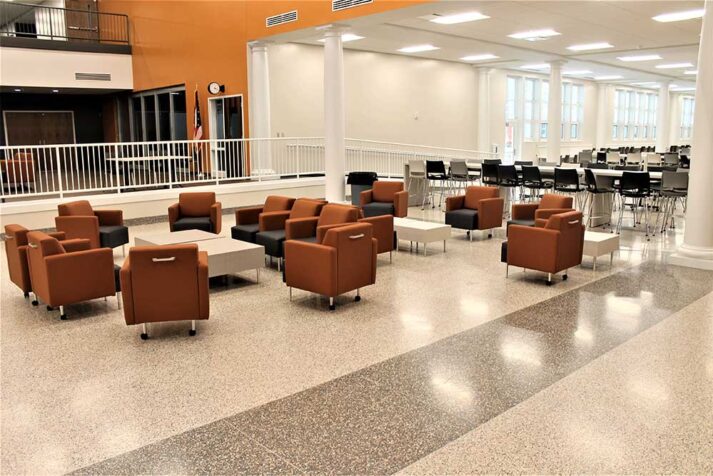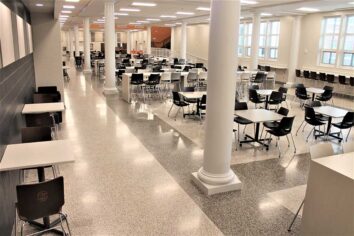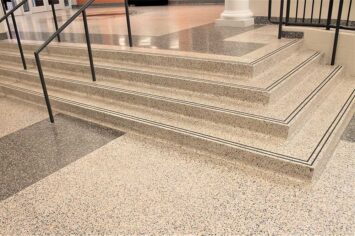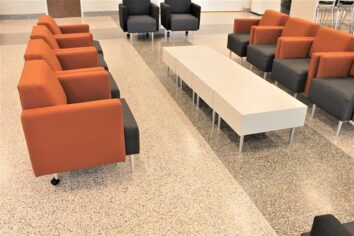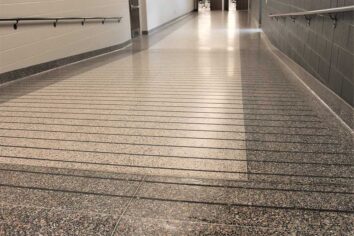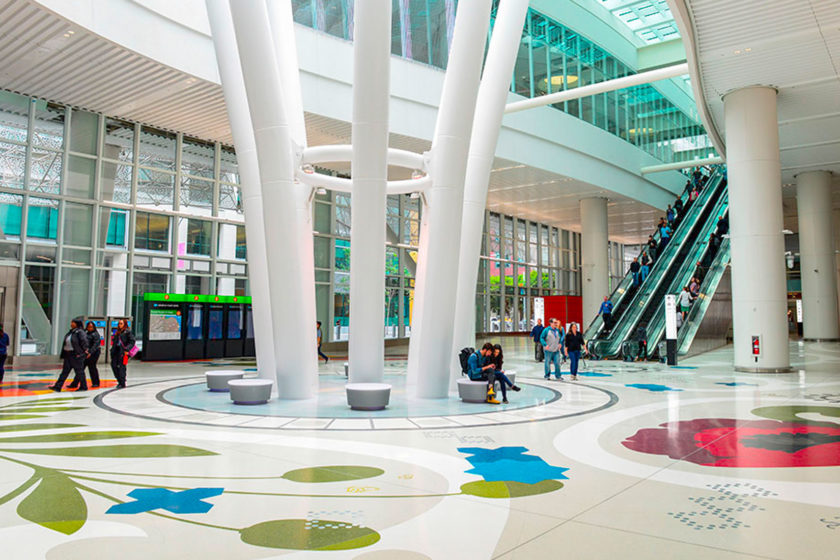What to Know about Cement Terrazzo
North Olmsted School District’s new 330,000 square-foot campus on a 90-acre site near Cleveland stands as an example of progressive school design combined with classical elegance. Built to replace a middle school erected in 1930, the complex was designed to meet the needs of 21st-century academics. The LEED Silver project blends versatile learning spaces and advanced technology with late 19th-century Georgian architecture and traditional terrazzo floors.
The campus encompasses an athletic facility and an 850-seat performing arts center recognized by American School & University magazine with an Outstanding Design Award in the 2019 American School & University Educational Interiors Showcase. The school welcomed its first students, grades 6-12, at the commencement of the 2018-2019 academic year. The senior project manager was award-winning school designer Zora Pavlovic with ThenDesign Architecture of Willoughby, Ohio.
The choice of cement-based, sand-cushion terrazzo was an out-of-the-ordinary option for the 23,000 square feet of flooring, complemented with bright epoxy accents and completed with 2,000 square feet of precast base, and cast-in-place stairs. Over the past few decades, epoxy terrazzo has grown to account for the vast majority of terrazzo installations. The development of epoxy terrazzo in the ’60s and ‘70s revitalized the terrazzo industry, expanding the systems options for a variety of situations and requirements. Cement terrazzo remains one viable option of many for several reasons. Why cement? There are pros and cons to each system, explained Mark Moreal, vice president of O.A. Bertin Company of Cleveland, the terrazzo contractor on the project.
The task force charged with studying North Olmsted’s options recommended investing in terrazzo flooring because of lower maintenance costs and a longer life than other floors. The school board wanted a seamless floor, and based on the district’s satisfaction with the sand cushion terrazzo installed in its oldest buildings, they chose to continue the tradition in their new building, according to Mr. Moreal.
The Right Side of Time
Time may often be the overriding factor in the decision to install one terrazzo system over another. Project timelines may not have the luxury of a cement terrazzo installation. It can take twice as long, with twice the workforce, Mr. Moreal explained. Wet grinding and removal of the slurry make cement-based terrazzo a messy proposition. Cement terrazzo requires a depressed slab and longer dry time.
On the other hand, epoxy terrazzo offers the shortest installation timeline, from pouring the material to grinding it smooth. However, the conditions of the job dictate how and when you can install it. Cement might be a better option for below-grade applications, for example.
“Water and epoxy don’t mix; if it’s damp, you can’t work with it,” said Mr. Moreal. With cement, as long as the water isn’t freezing, “you don’t need a temperature-controlled environment or even a roof over your head to install it,” he added.
At North Olmsted, time was actually on the side of a cement installation. The project officially broke ground on Oct. 17, 2016, and Mr. Moreal reported that their crews were able to begin the installation right after Christmas. In contrast, an epoxy terrazzo installation would have meant waiting until June.
The contractor’s main challenge was rainy Northeast Ohio weather in January. The job required hauling over 200 tons of sand into the heart of the complex through long corridors and working around other trades and equipment. The installation took five months.
A fourth-generation company founded in 1926, O.A. Bertin’s crews appreciate the chance to install sand-cushion terrazzo. It’s their personal choice of system for a new building; it’s less limited by the conditions of the job, Mr. Moreal explained: “Especially if the project is one color, why not do cement?”
Cracking: The Code
When is cement right, and when is epoxy better? Sand-cushion terrazzo can’t be installed in a renovation due to elevation. Cracks in the existing floor would telegraph right through monolithic or bonded cement terrazzo. If the substrate is cracked, epoxy is ideal for managing that situation, according to Mr. Moreal.
Epoxy is a more flexible material, and the capacity to include a crack-resistant membrane makes it a more generally preferred floor. No crack membrane is compatible with cement systems, which are also more subject to movement in the slab. A cement terrazzo floor requires a specific minimum of divider strips to account for expansion and contraction.
When used in conjunction with a flexible membrane, epoxy can absorb some horizontal concrete cracking and movement in the control joints.
Through Thick and Thin
A cement system requires 2.5 inches for the sand cushion, which can’t be added post-construction. Cement terrazzo is applied 2.5 to 3 inches with a half-inch terrazzo topping; it weighs in at 25-30 pounds per square foot compared to epoxy’s three to four pounds.
Epoxy terrazzo can be applied to substrates as thin as plywood, therefore providing a wide range of renovation options. A nominal 1/4- or 3/8-inch thick resin matrix veneer is placed on a flat concrete slab. Epoxy’s light weight is also ideal for multi-story use.
Epoxy offers higher tensile-compressive strengths than cement-based systems, and it is easier to maintain due to its very low absorbency and chemical resistance.
Design Matters
At North Olmsted, the brighter tones of orange and jet black were achieved with epoxy, installed with a moisture barrier underneath, within the sand-cushion field. The neutral colors of pigmented cement complimented the traditional design of the school. The muted tones of cement can be achieved with epoxy, and recent innovations can add color to cement.
A Skilled Craft
How is the craftsmanship different for the two floors? More process is involved in a cement installation. Mr. Moreal replied: “You have to have a feel for it; there’s a lot more to know. You have to know how to work with it. You can’t wait too long or go back too soon on the floor.”
Epoxy is mixed and then troweled down. The process for cement involves waiting, sprinkling dry material in, and rolling and troweling it. After four hours of cure time, it’s rolled again, and the excess swept off.
North Olmsted was a labor-intensive job, as are all sand cushion installations, Mr. Moreal concluded. “Not all contractors have the know-how or will even bid on cement terrazzo projects. It’s a dying craft in some areas.”
